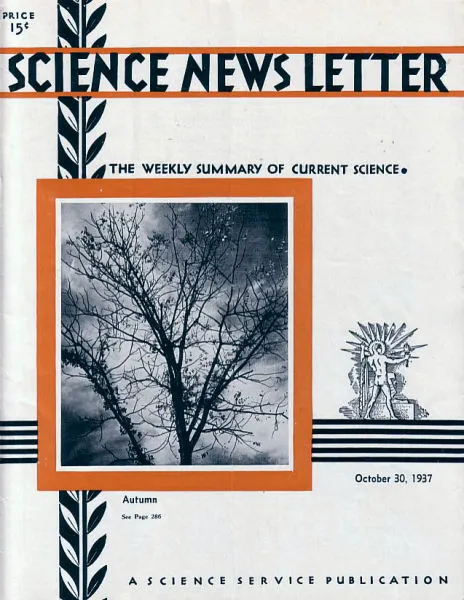From the October 30, 1937, issue

BARE BRANCHES OF TREES WARN OF COMING WINTER
With lingering leaves accenting the delicacy of the outlines traced by their branches against the clouded sky, the trees of autumn make an excellent subject for the hiking photographer.
The black walnut tree pictured on the cover of this week’s Science News Letter was taken with the camera of Fremont Davis, Science Service staff photographer.
CANCER MAY SPREAD IN BODY BY FRAGMENTS IN THE BLOOD
A new picture of how cancer may spread by the blood from one part of the body to the other was presented by Drs. A. Gordon Ide and Stafford L. Warren of the University of Rochester and Strong Memorial Hospital at the meeting of the National Academy of Sciences in Rochester, N.Y.
Color moving pictures showed fragments of cancer apparently drifting into a blood vessel in a rabbit’s ear. Such fragments of cancer, living and dead, probably drift into the blood in this way in far greater numbers than has previously been supposed, the Rochester scientists said.
The pictures possibly explain one method for the spread of cancer from one organ of the body to another. The blood travels to all parts of the body and is carried a good part of the way through a network of large, thin-walled veins. These thin walls are often broken by very slight injuries. Such a break in a vein as it traveled through a cancer would provide the chance for the cancer fragments to enter the blood and be carried to some distant organ.
This spread of the disease, known medically as metastasis, is one of the most dreaded features of malignant tumors. It is the imperative reason behind the drive for early diagnosis and early treatment of cancer. The surgeon can cut out a single cancer or tumor, can even in some cases remove one entire organ that is cancerous. X-ray or radium treatment can in many cases destroy cancer of one region. When, however, the cancer has had a chance to spread to many organs or to indispensable ones, the outlook for the patient is hopeless.
The pictures which today showed one possible method of this dangerous spread of cancer were made through a transparent double window of cellulose acetate film placed on the rabbit’s ear. A fragment of rabbit skin cancer was transplanted under the outer window. Through the window, with the aid of microscopes, the scientists were able to see the tiny blood vessels grow up, around, and into the growing cancer. Twice they observed a large blood vessel with an opening growing at the edge of the cancer. In addition, they were able to obtain a color moving picture record of a fairly large blood vessel in such state that blood serum, red blood cells and, apparently, cancer fragments could wash in and out with ease.
OIL FLOODED OUT OF WELLS BY NEW WATER METHOD
Oil is being recovered from Pennsylvania wells that have ceased producing profitably under other methods of working by a new water-flooding process developed by Pennsylvania State College scientists.
Water under pressure is forced into oil-bearing rock formations through selected wells to weep the oil out through other wells, in the new method of “reviving” nonproducing bores.
Six experts, including Dr. Kurt H. Andresen, Dr. Thomas S. Cooke, and H.B. Charmbury, have been working successfully on standardization of the method for 4 years.
Increasing attention has been paid by petroleum engineers the world over to the job of extracting the last remnants of oil from a pool as increasing numbers of fields give out. Blasting, to break up rock formations clogging the bottoms of wells, has been successfully developed in this country, while Russian engineers have used compressed air to achieve the same result.







